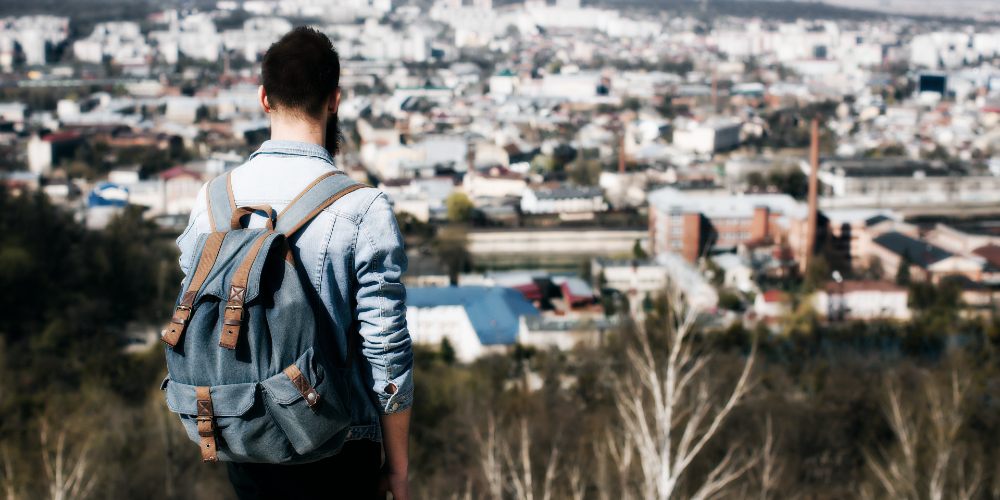Article by Fabian Ommar from The Organic Prepper cross-posted with permission.
(The Organic Prepper)—Streets and public spaces in large cities present a vast set of dangers and threats, even in more civilized and safer countries. That’s because criminals, predators, and deranged and evil people are present in greater numbers in urban agglomerations; the higher density of people and infrastructure means more opportunities for lawbreakers.
That’s becoming more evident today with the masses of “cultural enrichers” invading North America, the UK, and mainland Europe. But that’s not all: people everywhere are also losing their minds, thanks to the crisis and instability, causing friction and violence to rise. I believe this mass insanity will get worse as time passes.
This time, I wanted to go beyond the typical “situational awareness” advice and provide more practical and direct actions to improve personal safety, navigate big city streets, and deal with various situations and unwanted players.
#1 – USEFUL LIES
It’s perfectly fine to lie and create distractions and misdirections when dealing with strangers. When staying silent isn’t an option, use as few words as necessary. The more we talk, the more we give away or complicate ourselves, so keep it short so as not to get trapped in complex stories or contradict yourself.
– Don’t reveal your address.
When an app or taxi driver asks if you “live here,” say, “No, I’m just visiting a friend.” If possible, ask them to stop a few meters before or after your destination, maybe walk a block or two if your sixth sense tells you something’s off.
– You’re never alone.
This is great for women who are approached by a stranger or group, but it also works for men, depending on the situation. When someone tries to start a conversation by asking if you are accompanied (or whatever), just reply, “Yes, my husband/father/friend is here with me.”
– Never provide personal information.
When someone asks, “Do you work here?” “What’s your profession?” or inquires about personal information, casually give vague replies such as “I work in commerce.” Another appropriate reply I’ve used successfully is, “I just got fired and am looking for a job.”
– Never reveal your personal status and financial condition.
It’s silly to try and pass as dispossessed, but if a stranger starts probing (inquiring about your stuff), for instance, if your watch, purse, or piece of jewelry is genuine, tell them it’s a cheap knock-off in a nonchalant tone.
– You’re a savvy local.
If someone asks you, “Is this your first time here?” you can just say, “No, I’m from here,” and go on your way. If they insist, tell them you’re expecting someone and want to be alone to cut the conversation. Try not to look like a tourist. Search places and get directions beforehand to avoid browsing a smartphone in public areas.
– Be vague, play dumb, and ask questions.
People are afraid to pass for fools, and some street folks know how to take advantage of that. Acting a little loony can be useful in some situations. Shooting back with questions is another great way to deflect and uncover information simultaneously without sounding menacing or intrusive. When it comes to delivery, be playful and relaxed or firm and decided, depending on how you choose to act.
Here’s more advice on how not to give out personal information.
#2 – ASSERT A BOUNDARY
A boundary is for your protection, so forget about someone else’s feelings. Get comfortable making people uncomfortable once they cross your boundaries. Be assertive: Don’t ask, don’t wait for further advancements, and be direct (“I need you to take a step away,” “I need to leave now”), firmly but without sounding nervous or raising your voice. Daisy wrote more about this here.
#3 – BE PATIENT
We live in an era of instant gratification and short attention spans. But some things can be rushed in the streets, and many others cannot. The situation has a vote: It dictates what we can (or should) and cannot (or shouldn’t) do.
When I’m out there as a homeless person, I have to bide my time and wait for the right opportunity to do something I want or need all the time. It’s a good exercise, so much so that I talk about it in my street survival training book.
#4 – BE OBSERVANT
Most people walking in public spaces or riding in buses and trains might be somewhat aware of their surroundings and not with their heads in the clouds, but that’s different from being actively observant.
Paying close attention to details and the environment can be a superpower, improving our safety and other aspects of our lives. It requires focus, commitment, and being fully 100% in the moment. It’s a skill that can be developed and improved with practice.
For instance, when riding in a taxi, memorize the color, license plate, and any outstanding details. It’s OK to take a picture if that helps or you cannot memorize everything at the moment, but keep paying attention: How is the car inside and outside? Does the driver have tattoos? Are they tidy and well-presented? Does he or she look intoxicated? Calm, nervous, or agitated?
Another example: when riding a bus or train, take a look before grabbing a handle or taking a seat. Does it look stained or wet? Is there something under the seat, a backpack, a paper bag, or any suspicious object?
#5 – USE EMPATHY TECHNIQUES
In the streets, it’s not uncommon to negotiate something or persuade someone to settle or find a solution to a problem, dispute, contentious matter, or even get out of trouble. Advanced empathy techniques can work well for that and lots more. They can be imperceptible and highly effective if applied properly and subtly to come out naturally.
Some say that’s manipulation, but if your safety and well-being are at risk then who cares, anything is acceptable. Consider this an introduction. Advanced social engineering techniques are a complex and extensive subject, but it is worth reading a few books and practicing to improve these valuable skills.
– Mirroring
The act of unconsciously copying another person’s gesture, speech pattern, or attitude is known as mirroring, and it can help someone establish a connection with others. Another name for it is the chameleon effect.
Mirroring can help build rapport with the person being mirrored by making them feel more connected to the person displaying the mirrored behavior. The two people in the scenario may think they have comparable attitudes and beliefs because they use similar nonverbal cues. Individuals experience a stronger sense of engagement and belonging as a result.
– Reading people
I’ve already gone over the importance of street reading for urban survival here on The Organic Prepper for city dwellers. People-reading is another valuable skill, as we inevitably encounter situations where we must deal with another person or even a group of persons.
Some people are natural-born “people readers.” It’s a talent, a very useful one. Good sales and businesspeople are two examples (politicians are another, unfortunately). But it’s perfectly possible to train and develop this ability. Sales and business courses, as well as police academies, usually teach techniques of what to look for and listen to when interacting with others.
But it doesn’t have to be anything fancy. It’s possible to become a good people reader just by observing people with attention and open mind. Humans are overly self-centered, which keeps us from becoming good at listening and reading others. Once we let our ego aside and dedicate ourselves to understanding and seeing others for what they are – without judgment, bias, prejudice, etc. – it starts coming.
– Reverse psychology
Reverse psychology is a persuasion tactic that involves advocating or pushing for a behavior different from the desired outcome. In other words, we say the opposite of what we want to encourage the other person to do what we actually want.
It works based on a psychological phenomenon known as reactance, which is having a strong negative reaction to someone attempting to persuade us. As a result, we do the opposite of what they are trying to persuade us to do in an unconscious effort to assert our independence and autonomy.
Parents, lovers, and marketers might know this well—or not. We use this strategy on others all the time and fall for it, too, often without even realizing it. Usually, the target of this strategy is unaware of what is going on and may not be completely aware of the other person’s true intentions.
#6 – BONUS: 15 Short rules to survive in the big city
- Nothing in the streets is personal, so don’t take anything personally. If someone bumps, attacks, or shouts at you, it’s because the attacker is either (a) having a bad day, (b) mentally ill (or on drugs), or (c) wants something from you (a robber, beggar, solicitor, etc). Ignoring and moving away is the best strategy.
- Step back in avoidable danger. Step up in unavoidable danger.
- Stereotyping can keep you safer than a firearm: be wary of suspicious types, but don’t neglect or make things easier for anyone, regardless of sex, age, size, appearance, uniform, or whatever. Ignore all PC bullsh*t if you want to stay alive.
- Trust your instincts and always err on the safe side.
- Decaying infrastructure can be a hazard. Keep your head on a swivel, but scan ahead and pay attention to where you’re going.
- In the streets, we command things by the way we conduct ourselves. Opt for non-verbal language to communicate your intentions.
- You don’t have to respond, argue, justify, or pontificate. When in doubt, remember that silence can’t be misquoted.
- Stay in control of yourself. When having a conversation, keep your voice low and delivery calm, paced. If you start feeling nervous, pause and, slow down, pay attention to your breathing.
- Nodding is a way to let someone know you notice their presence. If you must acknowledge a stranger (for whatever reason), nod down. It’s more formal and doesn’t look defiant. If you know the person, it’s OK to raise your chin and nod up. This works in most Western cultures and places.
- Never stop moving. If you must stop to browse your phone or take a call or whatever, turn your back to a building or wall facing the sidewalk, give a 360 look, and be quick. Or enter a safe place. Jaywalking is OK if it’s safer than standing still waiting to crosswalk.
- Don’t look at anyone. Eye contact means you acknowledge the other person. The exception is when you want to let someone know you noticed them for some reason, for instance, to disarm a surprise attack you see coming (see “nod up vs. nod down” above).
- Stay alert for situations in which every second counts. These are the exceptions but matter the most. The rest, not so much, so chill.
- To keep strangers from getting close, extend an arm with the hand open in their direction and say “can’t stop now” in a firm tone and go your way.
- Wear shoes you can run in. If you must wear high heels or formal shoes for work or an event, arrive and leave in sneakers.
- Keep your head down when riding the subway or bus. Don’t stare. If you must look at something or someone without being noticed, use reflective surfaces (e.g., windows, storefronts, your smartphone, etc.). Get more advice on public transit safety here.
What are your thoughts?
Do you have any tips or suggestions to add to this? If you must be in the city, do you have any personal rules you abide by? What advice would you give to someone who was going to some type of event or appointment in the city? Are you an urban dweller yourself? Do you disagree with any of Fabian’s advice?
Sound off at the Late Prepper Substack.
About Fabian
Fabian Ommar is a 50-year-old middle-class worker living in São Paulo, Brazil. Far from being the super-tactical or highly trained military survivor type, he is the average joe who since his youth has been involved with self-reliance and outdoor activities and the practical side of balancing life between a big city and rural/wilderness settings. Since the 2008 world economic crisis, he has been training and helping others in his area to become better prepared for the “constant, slow-burning SHTF” of living in a 3rd world country.
Fabian’s ebook, Street Survivalism: A Practical Training Guide To Life In The City , is a practical training method for common city dwellers based on the lifestyle of the homeless (real-life survivors) to be more psychologically, mentally, and physically prepared to deal with the harsh reality of the streets during normal or difficult times. He’s also the author of The Ultimate Survival Gear Handbook.
You can follow Fabian on Instagram @stoicsurvivor
























Leave a Reply